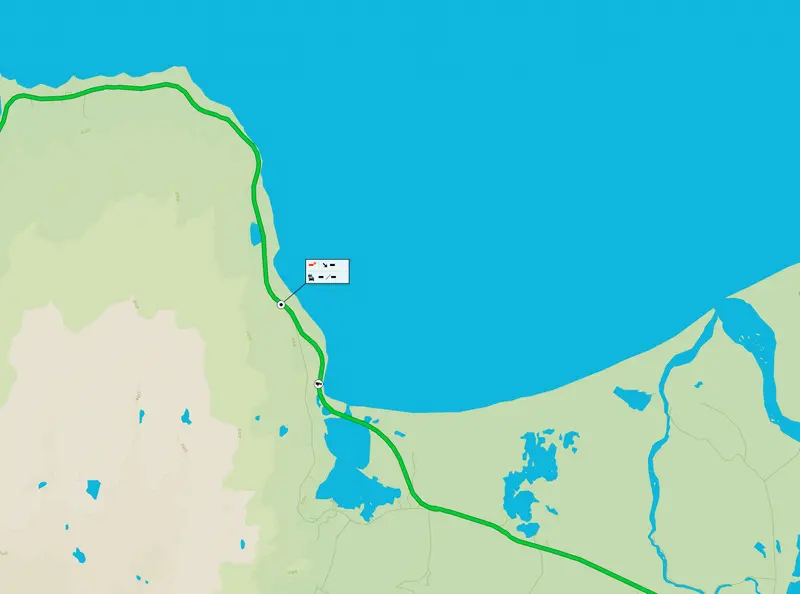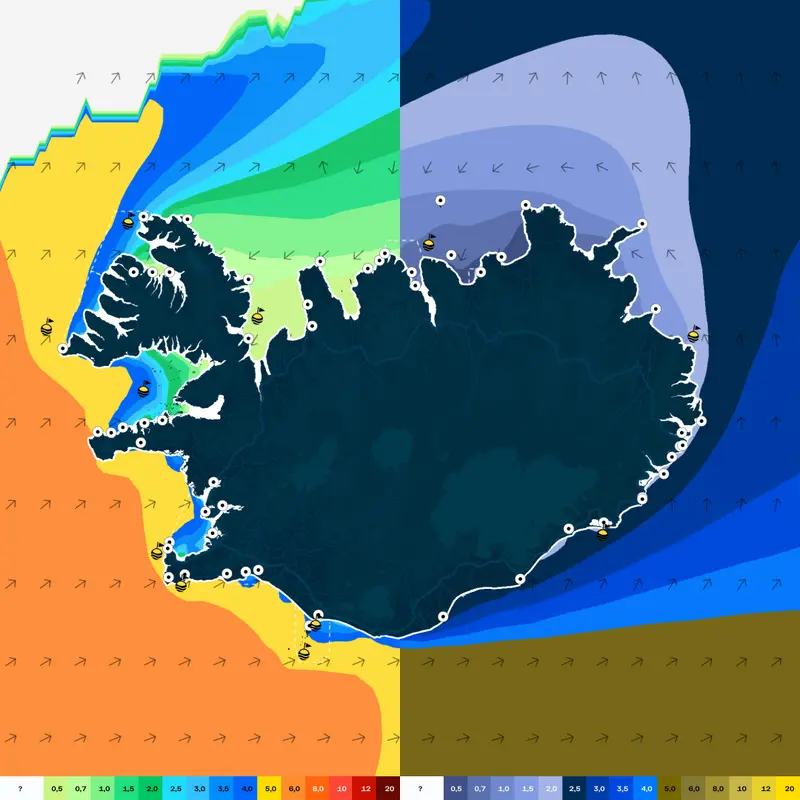Lights and sailing guidance
The IRCA handles the operation of the land light system, and manages the construction of lighthouses and navigational aids. IRCA maintenance and supervision of lighthouses is divided, roughly, into the monitoring of light equipment on one hand and the maintenance of the lighthouses themselves on the other.

The IRCA's role
The IRCA is responsible for providing seafarers along the Icelandic coastline, and within Icelandic fishing territory, with the necessary guidance for safe sailing through the operation of various route marking systems placed outside ships. These route markings include lighthouse beacons, electronic AIS (Automatic Identification System) signals, and marine navigational aids, either situated on land or floating along the coastline. In addition, various navigational equipment is operated, such as radar beacons, radar detectors, and accelerometer buoys. The system in its entirety is known as the land light system.
The IRCA also offers technical assistance and consultation for the construction of route-marking systems within Iceland’s harbours, and has the authority to demand that the relevant port authority commission, at their own cost, lights and other route markings which IRCA deems necessary for safe sailing within the harbour. The route markings system within harbours is referred to as the harbour light system. The joint name for the land light system and the harbour light system is “The Icelandic Beacon System.”
In addition to this, the information system sjolag.is is also operated on the IRCA’s website. The website publishes meteorological information from weather stations located in selected lighthouses, as well as measurements obtained from 11 wave sensors located all around the country.
IRCA maintenance and supervision of the country’s lighthouses is divided into the supervision of electrical, and light equipment on one hand, and the maintenance of lighthouse buildings and navigation systems on the other. It is necessary to properly maintain the exterior of all lighthouses, since they are used as day marks by seafarers, and the lights are often located in places heavily exposed to salty winds and all sorts of extreme weather conditions.
According to provision 13 of the International Convention for the Safety of Life at Sea (the SOLAS resolution of 1974,) all member countries are obligated to install a marine navigational system as is deemed appropriate for the level of marine traffic received by the respective country, whilst also taking account of the local danger level.
Navigational lighthouses and harbour lighthouses
The Icelandic beacon system is divided into two main categories: navigational beacons and harbour beacons. The navigational beacon system comprises all lighthouses and other route markings/navigational aids that are considered beneficial to both general marine traffic along the coast, as well as to fishing vessels. Harbour beacons are the lighthouses and other navigational aids which provide navigation assistance for vessels sailing into a specific harbour area. A harbour area is defined as the area encompassing the harbour’s jurisdiction.
The navigational beacon system consists of 104 lighthouse beacons, 11 buoys, and 16 radar beacons placed where the surrounding landscape makes it difficult for radar signals to be displayed aboard vessels.
The harbour beacon system consists of little less than 20 lighthouse beacons, around 90 entry lights on levees or piers, more than 80 navigational light ribbons, and just under 50 buoys which mark safe entry into the harbour.

The lighthouse at Málmey
Navigational aids for seafarers
Marine navigational aids are the equipment, systems, or services situated outside of vessels, which are designed and used to increase safety and efficiency for marine traffic and navigation.
If a port authority, or private individual wants to set up marine navigational aids, their construction and location shall be decided in cooperation and council with the IRCA. Marine navigational aids cannot be implemented until an inspection has been performed by the Icelandic Transport Authority, which then has the responsibility to advertise the navigational aid according to Act No. 132/1999 on Lighthouses.
Any port authority or individual, having gained authorisation to implement a navigational aid, is obligated to maintain the aid, and to notify the Icelandic Transport Authority and the IRCA of any changes made to it, without delay. If a navigational aid is deemed to not be sufficiently maintained, in the opinion of the Icelandic Transport Authority and the IRCA, the IRCA is then authorised to carry out the necessary repairs, at the expense of the owner. Should the port authority or individual wish to discontinue the use of, or change the navigational aid, an application can be submitted to the IRCA.
The IRCA has the authority to demand that a port authority construct, at their own cost, lights and other navigational aids which the institution deems necessary for safe sailing in the relevant harbour area. Maintenance and operation of these lights and navigational aids also fall under the port authority’s cost.
Act No. 132/1999 on Lighthouses (Icelandic only)
Types of navigational beacons
- Light towers: A light tower is a large lighthouse that only emits white, usually rotating light. It has a total luminous range of 10 nautical miles, and serves as a navigational aid for vessels closing in on the coast as they arrive from the open sea.
- Route markings: A guiding line adorned with beacons and day shapes. It is clearly visible throughout the entire maritime traffic lane.
- Sector lights: This type of light marks safe sailing routes with white light and dangerous corners/sectors, shallows or other danger and areas that are unsuitable for sailing, such as port areas, with variously coloured lights.
- Port lights: Smaller lighthouses which mark entry into the harbour.
- Directional lights: A lighthouse that marks maritime traffic lanes without day shapes in narrow areas. Such lighthouses can be easily spotted from the fact that their light is only visible in carefully demarcated areas.
- Aeronautical beacon: A light beacon that emits a high beam most often visible from a larger distance than light from a beacon for seafarers. Aeronautical beacons do not fall under the operation or management of the IRCA, but they are nevertheless registered in the List of Lights as marine navigational aids.
The lighting and extinguishing times of lighthouses and navigational aids:
The time Icelandic lighthouses and navigational aids are lit is determined by the latitude 65’30 north.
Light sensors are used to turn the lights on and off, consequently, the time they are lit depends on daylight, not location. Nevertheless, some lights are lit 24 hours.

The lighthouse at Selsker

The lighthouse at Seley
List of lighthouses
The List of Lighthouses is given out by the Icelandic Coast Guard, while the IRCA is responsible for its publication according to the Act on Lighthouses. Included in the register are lights, their locations, characteristics etc., buoys, radar beacons, marine navigational aids and more. Below you will find an overview of Icelandic lights.
Lighthouse history
In the autumn of 2002, the Icelandic Maritime Administration published a book on the history of the Icelandic lighthouse service: Vitar á Íslandi: Leiðarljós á landsins ströndum 1878-2002, written by Guðmundur Bernódusson, Guðmundur L. Hafsteinsson and Kristján Sveinsson. This book describes the history of the Icelandic lighthouse service, from its origin to contemporary times. Described within is the development and operation of the lighthouse system, the role which lighthouse keepers have played in the system is analysed, and finally the connection between lighthouse architecture, contemporary trends and styles is explored. The book is also adorned with a number of photographs.
Law and regulation
Documents in Icelandic
International rules
- International resolution for the Safety of Life at Sea, SOLAS, Chapter V. (Safety of Navigation for all vessels at sea)
- International resolution of the International Maritime Organization for the Facilitation of Transport by Sea, FAL 1965.
- The Icelandic Transport Agency website hosts the SOLAS and FAL 1965 Conventions.
In particular, Chapter V of the International Convention specifically states that that chapter shall apply to all ships at sea, and not just SOLAS ships as other chapters of the Convention specify.
Thus, Chapter V does not distinguish between seafarers in any way other than what can be inferred based on navigation frequency, and the risk present therein, regardless of the type of ship that sails.
List of lighthouses
Below you can see the list of all of Iceland’s lighthouses: the name of the lighthouse, light characteristics, distance, location and number are all included. The lighthouses in the list below are the lighthouses that are monitored and maintained by the IRCA.








